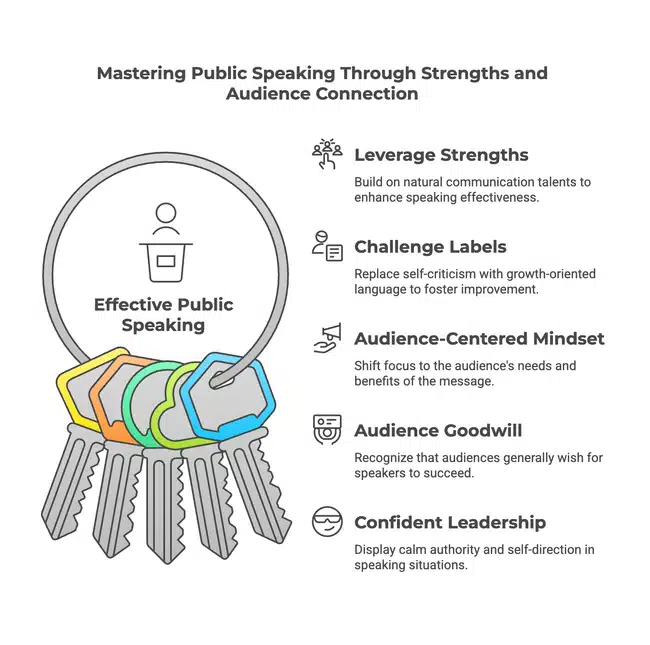Best Noise-Canceling Headphones for Writers: Enhance Focus and Creativity
Mastering the Inner Voice: How Positive Self-Talk Transforms Public Speaking

Public speaking ranks among our most common fears, but a powerful antidote lies within our own minds. The way we talk to ourselves before and during presentations can dramatically influence our performance and confidence levels. Developing strong public speaking skills requires not just external practice but internal preparation – a mental rehearsal where positive self-talk becomes your most powerful tool.
The Power of Reframing in Public Speaking
When your heart races and your palms sweat before a presentation, how you interpret these sensations makes all the difference. Rather than seeing them as signs of nervousness, successful speakers reframe these physical responses as positive excitement. This simple perspective shift can significantly reduce anxiety by changing the story you tell yourself about what's happening in your body.
“What if my voice shakes?” becomes “My body is energized and ready to engage.” This reframing technique doesn't deny the physical sensations but transforms their meaning, allowing you to channel that energy constructively when delivering a speech.
From Self-Doubt to Self-Affirmation
Our minds often default to worst-case scenarios: “I'll forget everything” or “They'll think I'm incompetent.” Countering these thoughts with positive affirmations creates a foundation for confidence:
- Instead of “I might make a mistake,” try “I'm well-prepared and know my material.”
- Replace “They'll judge me” with “The audience wants me to succeed.”
- Transform “I'm too nervous” into “This energy shows I care about delivering value.”
These positive statements actively counteract fear while building genuine self-assurance. Before important presentations, many accomplished speakers create personalized affirmations or phrases that address their specific insecurities, repeating them during preparation and immediately before taking the stage.
Beyond Self-Focus: Finding Your Purpose
Perhaps the most powerful shift happens when you redirect attention from yourself to your message and audience. When anxiety surfaces, acknowledge it briefly, then recenter on the purpose behind your words.
This purpose-driven approach transforms delivering a speech from a performance evaluation to a meaningful exchange. Your focus shifts from “How am I doing?” to “What does my audience need?” This subtle but profound change alleviates pressure while enhancing authentic connection.
Visualization: Rehearsing Success Mentally
Elite athletes have long used visualization techniques to enhance performance, and speakers can benefit similarly. Before you practice in front of anyone, spend time mentally rehearsing your presentation. Imagine yourself standing confidently, speaking with clarity, connecting with audience members, and skillfully navigating questions.
This mental rehearsal activates many of the same neural pathways as physical practice. Visualization primes your brain for success by creating a template of positive expectations. Specifically picture:
- Your composed entrance and confident posture
- Clear articulation of key points
- Engaged audience members nodding in agreement
- Smoothly handling potential challenges
- Receiving appreciative applause after your conclusion
When you finally practice in front of others, your mind has already experienced success, making actual delivery feel more familiar and comfortable.
Practical Strategies for Positive Self-Talk
Here are additional techniques to transform your inner dialogue and enhance your public speaking skills :
- Leverage your strengths: Recognize and build upon your natural communication talents, whether that's storytelling ability, analytical clarity, or authentic enthusiasm.
- Challenge limiting labels: Replace self-criticism (“I'm terrible at public speaking”) with growth-oriented language (“I'm developing my presentation skills with each opportunity”).
- Adopt an audience-centered mindset: Shift focus from “me” to “we” by emphasizing how your message benefits listeners.
- Remember audience goodwill: Most people genuinely want speakers to succeed and are rooting for you, not judging you.
- Project confident leadership: Through conscious self-direction, display calm authority even when you don't initially feel it.
- Prepare thoroughly: Nothing builds confidence like mastery of your material—anxiety diminishes when you know your content deeply. Also, brush up on some public speaking best practices by reading one of our suggested books on public speaking, or taking a course on public speaking.
Building Resilience Through Constructive Reflection
After delivering a speech, many speakers immediately focus on what went wrong. Positive self-talk extends beyond preparation to include constructive reflection. Instead of harsh self-criticism, try asking:
- What moments felt most successful and why?
- Which audience interactions were most valuable?
- What strengths did I demonstrate today?
- What specific areas can I improve next time?
This balanced approach acknowledges areas for growth while reinforcing confidence. Each speaking opportunity becomes not just a test but a building block for future success.
The Cumulative Effect
The beauty of positive self-talk lies in its compounding benefits. While it might feel awkward initially, consistent practice creates new mental pathways that eventually become your default mode of thinking. With time, the voice in your head transforms from your harshest critic to your most supportive coach.
Many accomplished speakers report that their internal monologue gradually shifted from fearful to encouraging through deliberate practice. This transformation doesn't happen overnight, but with persistence, positive self-talk becomes more natural and automatic.
Integrating Positive Self-Talk Into Your Preparation Routine
To maximize the benefits of positive self-talk, integrate it systematically into your preparation process:
- Begin with affirmations during initial content development
- Incorporate visualization as you refine your material
- Use purpose-centered reminders when you practice in front of others
- Implement calming self-talk immediately before delivering a speech
- Engage in constructive, positive reflection afterward
By consciously reshaping your internal dialogue at each stage, you can not only overcome stage fright but actually harness your nervous energy to deliver more authentic, impactful presentations. Your audience doesn't hear your thoughts—but they absolutely feel their effects in your delivery, presence, and connection. This internal work may be invisible, but it fundamentally transforms your external public speaking skills in ways your audience will unmistakably recognize.
Yes! I want Bad Grammarian updates and promotions!
No Spam Zone. We will never spam or sell your email address!
Yes! I want Bad Grammarian updates and promotions!
No Spam Zone. We will never spam or sell your email address!




